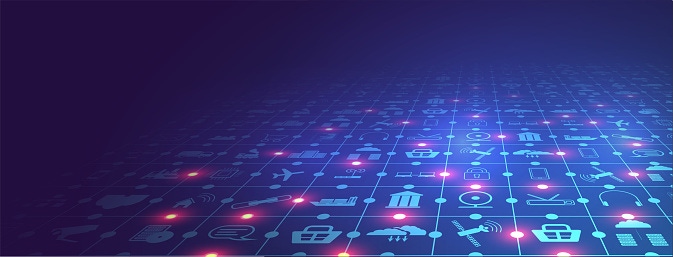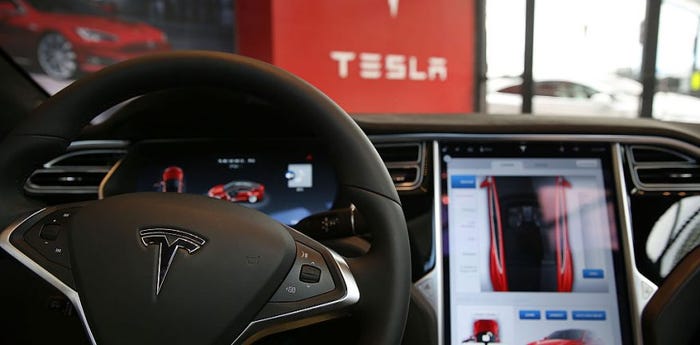IoT Automation Trend Rides Next Wave of Machine Learning, Big Data
IoT automation has found new raison d’etre in the COVID-19 era.
July 31, 2020

An array of new methods — along with unexpected new pressures — cast today’s IoT automation efforts in an utterly new light.
Progress today in IoT automation is based on fresh methods employing big data, machine learning, asset intelligence and edge computing architecture. It is also enabled by emerging approaches to service orchestration and workflow, and by ITOps efforts that stress better links between IT and operations.
On one end, advances in IoT automation include robotic process automation (RPA) tools that use sensor data to inform backroom and clerical tasks. On the other end are true robots that maintain the flow of goods on factory floors.
Meanwhile, nothing has focused business leaders on automation like COVID-19. Automation technologies have gained priority in light of 2020’s pandemic, which is spurring use of IoT sensors, robots and software to enable additional remote monitoring. Still, this work was well underway before COVID-19 emerged.
Cybersecurity Drives Advances in IoT Automation
In particular, automated discovery of IoT environments for cybersecurity purposes has been an ongoing driver of IoT automation. That is simply because there is too much machine information to manually track, according to Lerry Wilson, senior director for innovation and digital ecosystems at Splunk. The target is anomalies found in data stream patterns.
“Anomalous behavior starts to trickle into the environment, and there’s too much for humans to do,” Wilson said. And, while much of this still requires a human somewhere “in the loop,” the role of automation continues to grow.
Wilson said Splunk, which focuses on integrating a breadth of machine data, has worked with partners to ensure incoming data can now kick off useful functions in real time. These kinds of efforts are central to emerging information technology/operations technology (IT/OT) integration. This, along with machine learning (ML), promises increased automation of business workflows.
“Today, we and our partners are creating machine learning that will automatically set up a work order – people don’t have to [manually] enter that anymore,” he said, adding that what once took the form of analytical reports now is correlated with historic data for immediate execution.
“We moved past reporting to action,” Wilson said.
Notable use cases Splunk has encountered include systems that collect signals to monitor and optimize factory floor and campus activity as well as to correlate asset information, Wilson indicated.
Hyperautomation Hyped
The move toward more coordinated, highly integrated systems automation is strong enough that Gartner has dubbed it “hyperautomation,” and included it in its “Top 10 Strategic Technology Trends for 2020.”
The research group describes hyperautomation as “the orchestrated use of multiple technologies to catalyze business-driven process change,” and declares “everything that can be automated, will be automated.”
The hyperautomation category includes process and task automation tools, ML, event-driven software and RPA, according to Gartner. Estimates of Coherent Market Insights valued a global market for hyperautomation at $4.2 billion in 2017, and predicted 18.9% CAGR from 2019 through 2027.
Automation — hyper or other — is supported in several products. These include workflow orchestration software from companies ranging from Broadcom and BMC to Radianse and Resolve Systems. The space also holds players like ServiceNow and Splunk.
The ranks include industrial IoT automation systems from GE, Honeywell, Rockwell Automation, Plex, PTC and Siemens, as well as IT infrastructure and ERP application software such as C3.ai, IBM and SAP.
And, that is not to mention domain specialists like Esri, with geospatial data processing; Dassault Systèmes, with 3D Design and engineering software; and many others working to automate aspects of IoT.
Business Process Automation
For Radianse, which integrates intelligent tracking and management software with tagged RFID and non-RFID devices, IoT automation means expanding real-time monitoring of staff tasks and automation of schedules from elder care facilities and hospitals to gyms, fitness centers and even bars.
In hospitals, naturally, asset tracking has gained new importance as respirator demand has vaulted. Cleaning schedules, too, now require new levels of tracking and efficiency. Change here is rapid.
“With the COVID-19 pandemic, you see pivots in approaches. You see interfaces that don’t require touch menus, or that interface to users’ own devices,” according to Randy Ribeck, vice president of strategy for Radianse.
Ribeck said the company works with customers to implement systems that automate scheduling and asset use, and that the influx of data can be challenging. So, paring down incoming data to the essentials is an important mission. “Otherwise, at times, you can be drinking from a fire hose,” he said.
ITOps Automation
Agility has been the mantra of many organizations for years. That’s taken the form of DevOps, ITOps, MLOps and AIOps. All are methods organizations use to automate the repeatable steps developers and administrators take to keep apps running.
As use of IoT devices grows, more automation is being applied. Basically, more organizations are taking on the workflow styles of traditional telcos or cloud providers.
“There is a common problem around the proliferation of IoT [devices]. Organizations are left to manage all of these ‘things,’ to make sure they are working properly,” said Vijay Kurkal, CEO, Resolve Systems, maker of an AIOps platform for enterprise-wide incident response, automation and process orchestration.
The problems grow greater as IoT devices take on more tasks. He cites one of the most ubiquitous of ‘Things.’ That is, the ATM.
“More than ever, banks need to know ATMs are up, running and functioning. That is because each ATM now serves multiple applications. If they fail, you lose business and customers are frustrated,” Kurkal said.
Moreover, a “truck roll” that requires technicians to be dispatched (in a truck) to ATM locations is expensive. All that makes AI and automation an integral part of capable incident resolution planning, he said.
IoT Automation on the Map
Automation takes on a different aspect when IoT data is introduced, according to Susan Foss, product manager for real-time visualization and analytics at Esri, the geographic information system (GIS) giant.
What is different? “It’s the nature of the data being collected,” she said. “Organizations have never had this type of information before or at this granularity of time-space detail.”
“Before it was more periodic. Now they have it in the form of a living, breathing, constant supply,” she added. That ushers in event processing architectures, changes the pace with which teams have to work with data, and augers more automation.
Foss said Esri is working with users to connect fast-arriving IoT data to location data. The goal is to create immediate visualizations of data on a map. This requires, Foss said, “a delicate balance of compute horsepower against the incoming real-time data, as well as static data sources that might need to be used with it.”
And, real-time activity mapping is going indoors in the face of the COVID-19 pandemic. To that end, Esri recently updated its ArcGIS Indoors offering with new space planning templates. The software uses beacons and Wi-Fi to collect data for display on a live map showing activity in offices and other physical plants. Clearly, such capabilities have special import in the wake of coronavirus.
Retooling for the Next Normal
Subtle changes are underway in IoT automation, driven by global events, according to Prashanth Mysore, director of DELMIA marketing and strategic development at Dassault Systèmes.
For one thing, a “next normal” is focused on ensuring employees safety and security, Mysore said. He also anticipates more change in supply chains, as closer connections to sourcing become more important, and real-time monitoring of supply chains is needed.
Mysore said systems simulation and 3-D modeling will help in this regard, particularly where much new “what-if” analysis of system behavior must be swiftly completed. Like others, he singles out lightning-fast shifts to ventilator manufacturing by auto makers and others as a harbinger of things to come.
“Things are so dynamic. For example, people have to look at how remote operations and networking affect security,” he said, pointing as well to an upsurge in remote IoT system maintenance in times to come. This move to greater operational flexibility also signals the need for convergence between IT systems and operational systems, Mysore indicated.
Autonomizing the Unpredictable
Of course, the factory floor remains the citadel of automation. Key factors at play are big data, ML and the general trend toward digitalization, according to Juan Aparicio, head of advanced manufacturing automation, Siemens Corporate Technology.
Aparicio said these factors combine to create what he calls “autonomous automation.” This next step for automation, it seems, is to venture into the realm of the unpredictable.
In traditional or classical automation, there is explicit motion programming, explains Aparicio. Tasks and procedures are static and repetitive. That’s due for change.
“Historically, we have been very good at automating the predictable process. For example, the welding line in automotive assembly,” he said. This approach faces issues, if parts are not represented perfectly. And changing these systems is programming intensive.
With next-generation autonomous automation, systems are based on ML modeling, rather than explicit programming, said Aparicio, who describes this as a move “from automating the predictable to autonomizing the unpredictable.”
As the recent COVID-19 rush to retool production lines showed, shifts in production can be challenging. This could be a job for autonomous automation, which Aparicio posits as a means toward more flexible automation and robotics.
Edge Computing Fits
IoT implementers should be aware that greater automation is about more than machine learning algorithms. Team leaders must also understand the full life cycle of products.
“Autonomous automation means you have to extract the data, maintain it, figure out where you store it — it’s a different computing architecture, requiring a new way of planning,” Aparicio said. “Nothing comes free, machine learning is very compute and data intensive.”
An answer to that issue in some cases will be robotics linked with edge computing. “It makes a lot of sense to put computer power very close to the process,” Aparicio said. “Edge fits well.”
At the same time, autonomous automation should be viewed as an addition to classic automation methods, not a complete replacement, Aparicio said.
From the days of the Jacquard automated loom through to Henry Ford’s automated assembly line and beyond, automation has driven new technology use. Clearly, the technologies now ready to meet that call are many, giving tech leaders plenty to ponder as they reimagine automation as it applies to IoT.
About the Author(s)
You May Also Like



.png?width=700&auto=webp&quality=80&disable=upscale)
.png?width=700&auto=webp&quality=80&disable=upscale)
.png?width=300&auto=webp&quality=80&disable=upscale)
.png?width=300&auto=webp&quality=80&disable=upscale)
.png?width=300&auto=webp&quality=80&disable=upscale)
